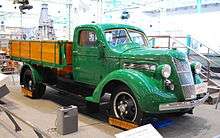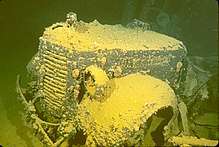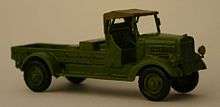Toyota G1
The Toyota G1 was the first truck built by the company that became Toyota. It was 6 m (20 ft) long, could carry 1.5 tons and was loosely based on similar class Ford and GM trucks.
The G1 was succeeded by a line of similar Toyota trucks as technology progressed. The entire series was replaced by the BM truck in 1947.[1]
G1
Kiichiro Toyoda's desire was to produce automobiles. Unfortunately, the A1 passenger car that was under development in 1935 was unlikely to sell well due to Japan's underdeveloped economy. Work still progressed on the A1 but emphasis was shifted to a truck derived from the same engine and chassis (slightly lengthened).[2]
The financial resources of the parent company, Toyoda Automatic Loom Works, were stretched almost to breaking point and large loans were required to put the G1 into production. The total cost of the G1 development was well several times the annual profits of Toyoda.
The G1 was sold as a Toyoda. The company changed its name from Toyoda to Toyota at the introduction of the G1's successor, the GA.
Since this was Toyoda's first production vehicle, there were still many problems to be solved. When the first production examples were driven to Tokyo for the motor show, they were packed with many spare parts. These spare parts were in case something broke during the trip - luckily only a few replacement parts were required. Early sales were mostly to people who were sympathetic to local manufacturers and who were willing to endure many failures. To support them, design engineers from the factory were often sent to do repairs in order to learn which parts needed the most attention. For example, broken rear axle housings were common until new welding methods were developed. Repairs were done for free and sometimes entire trucks were replaced for free. Rectifications were then applied as running changes on the production line, reflecting Toyota's "5 Whys" problem solving philosophy.
Dates
The G1 prototypes were completed in August 1935, shown to the public in November 1935 and released for sale in December 1935. This was just in time to meet the government deadline for licensing motor vehicle producers.
GA
A minor update to the G1.
Dates and Production Figures
The GA replaced the G1 in September 1936. [3]
Mechanicals
Similar to the G1.
GB

A minor update to the GA, now fitted with the 75 PS (55 kW) Type B engine. In January 1940 the engine was upgraded and gained three horsepower; at the same time the shorter wheelbase HB model also appeared. The HB was built until May 1941. A bus was also built on the same, shorter chassis.[4]
Dates and Production Figures
Production was 19,870 units between December 1938 and April 1942.[3][5]
Mechanicals
Similar to the GA. Wheelbase is 3,609 mm (142.1 in), 3,300 mm (129.9 in) for the shorter HB.[4]
KB

An update to the GB to make it more suitable for war time production. The body was still made from steel but was of a simpler design with less curves.
Dates and Production Figures
Production was 21,130 units between March 1942 and March 1944.[1][6][7]
Mechanicals
Similar to the GB.
KC


An update to the KB to make it even more suitable for war time production in times of limited material availability, nicknamed "Toyota To-Ki." Emphasis was on reducing the cost of materials. The engine cover was still metal but other body panels were made from plywood. The body design was extremely square, with only simple curves used on the engine cover and a flat radiator with no grill. Only a single headlight and only rear brakes were used.[2][5][7]
The KC truck was used on Japanese military airfields to start aircraft engines. A power take-off was taken from after the gearbox. It rose behind the cabin and then projected forward. This was mated to the spinner on an aircraft's propeller to start the aircraft engine. Because it wasn't used for heavy cargo, the cargo bed was narrow and the rear wheels were singles instead of the normal doubles. Also, the cabin was very basic, having plywood sides, no doors and a canvas roof. Running boards were unique to the starter truck due to the narrow cargo bed. Hasegawa made a 1:72 scale plastic model of the KC starter truck labelled as "Starter Truck Toyota GB", even although the real GB had a curved radiator grill and more complex bodywork.
Dates and Production Figures
The KC was introduced in November 1943.[1][6] Production continued until March 1947, when it was replaced by the BM model.
Mechanicals
Similar to the KB.
KCY
A military amphibious vehicle using a metal boat style hull and KC truck mechanicals.
Dates and Production Figures
Production was 198 units between November 1943 and August 1944. [1]
Mechanicals
The engine, gearbox, suspension and rear axle were based on the KC mechanicals. In addition, 4-wheel drive was added via a 2-speed transfer case. Water propulsion was by a PTO driven propeller. Brakes were hydraulic.
References
- "Against all odds", Yukiyasu Togo & William Wartman, New York: St. Martin's Press, 1993, ISBN 0-312-09733-6, p56/73
- http://www.toyota.co.jp/Museum/data_e/a03_13_1.html#10
- 75 Years of TOYOTA, http://www.toyota-global.com/company/history_of_toyota/75years/vehicle_lineage/car/id60014785/
- "Toyota-fifty years in motion", Eiji Toyoda, Tokyo: Kodansha International, 1987
- History of Toyota: 1936, http://www.toyota.co.jp/en/history/1867.html
- "Toyota Model GB Truck: Description". Vehicle Lineage. Toyota Motor Corporation. Archived from the original on 2017-11-16.
- "The Observer's Army Vehicles Directory to 1940", Bart Vanderveen, London: Frederick Warne & Co., 1974, p263-265
- Vanderveen, Bart (1972), The Observer's Fighting Vehicles Directory, World War II, London: Frederick Warne & Co., p. 359
- Vanderveen, Bart (1989), Historic Military Vehicles Directory, London: Battle of Britain Prints Int'l